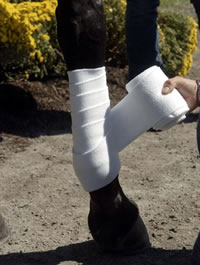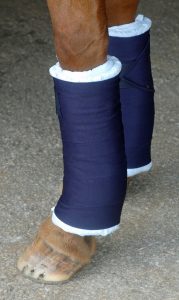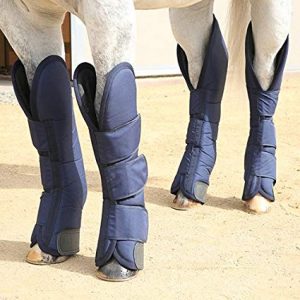Horse Leg Wraps
Neo Sports Lab has many years of experience in making horse leg wraps. We have developed various types of horse leg wraps to help horse owners.
Horse leg wraps have been used by horse owners to wrap horse’s legs to protect and cover an injured area; provide warmth and support to stiff or sore tendons, ligaments, or fetlocks; prevent or reduce swelling after exercise or during stall rest; and to protect his legs from injury during trailering or hauling.
Why Use Horse Leg Wraps?
Whether a horse is being used for jumping, eventing, dressage, reining, cattle work, trail riding, riding lessons, camp programs, or just as a pleasure horse, one thing is certain – they work hard, and so do their legs. The legs of a horse are certainly amazing. They take on extreme amounts of stress, bear a lot of weight, can move quickly so that the horse can change directions on a dime or jump over an obstacle, and they are one of the most important parts of the horse. Protecting a horse’s legs is imperative in certain situations, especially if the horse is young and still growing.
Horses that are faced with poor footing, uneven ground, a competition environment, transportation, or have a tendency to stock up (or have their legs swell) while in a stall, can benefit from leg wraps, boots, or bandages. It is important to know when and how to use each kind so that the horse’s legs are protected properly. Using leg wraps and boots incorrectly can cause problems for the horse and could accidentally put more strain on the horse’s legs and cause damage, such as inflammation of the flexor tendon and the flexor tendon sheath, which is sometimes known as the “bandage bow.”
Types of Horse Leg Wraps
 Polo Wraps: Polo wraps are stretchy, available in various colors and lengths, and help protect the horse’s legs from scrapes, bruises, and irritation from dirt, sand, and other types of arena footing. However, polos, also called track wraps, should not be used during trail riding since burrs and small sticks and debris can become attached to them and then cause the horse irritation as they dig into his skin. They are not recommended for use when putting the horse in a stall for a while or in turnout since they can easily become unraveled and torn if the horse steps on them. Many choose polo wraps over boots since they conform to the leg, however, if they become wet, they become really heavy for the horse. This can place additional strain on tendons and ligaments. Applying polo wraps incorrectly can also damage the horse’s leg. Polo wraps should be washed often since a dirty polo wrap can irritate a horse’s legs. For proper placement, check out CHA’s video called “How to Put Polo Wraps and Standing Wraps on Horses.”
Polo Wraps: Polo wraps are stretchy, available in various colors and lengths, and help protect the horse’s legs from scrapes, bruises, and irritation from dirt, sand, and other types of arena footing. However, polos, also called track wraps, should not be used during trail riding since burrs and small sticks and debris can become attached to them and then cause the horse irritation as they dig into his skin. They are not recommended for use when putting the horse in a stall for a while or in turnout since they can easily become unraveled and torn if the horse steps on them. Many choose polo wraps over boots since they conform to the leg, however, if they become wet, they become really heavy for the horse. This can place additional strain on tendons and ligaments. Applying polo wraps incorrectly can also damage the horse’s leg. Polo wraps should be washed often since a dirty polo wrap can irritate a horse’s legs. For proper placement, check out CHA’s video called “How to Put Polo Wraps and Standing Wraps on Horses.”
 Standing Wraps: Standing wraps, also called stable bandages, consist of padding that is wrapped around the horse’s legs using polo wraps. They help protect the horse’s legs, tendons, and ligaments, while the horse is in a stall. Standing wraps can be beneficial if a horse has a tendency to be restless in the stall, or if the horse’s legs tends to stock up (swell) after exercise or while in a stall. They can also be used in shipping, although shipping boots provide better protection. In addition, they can be used for certain injuries, but this should be at the discretion of a veterinarian. Using a wrap can help keep cuts, wounds, and other injuries clean while they heal. In addition, standing wraps are beneficial when poultices or liniments need to be used, again at the discretion of a veterinarian. A veterinarian should advise on the use of standing wraps with any product, since some products can produce excessive heat, thus causing the horse discomfort or pain if used under a wrap. Standing wraps stretch from the bottom of the knee or hock to below the fetlock and are always used with padding.
Standing Wraps: Standing wraps, also called stable bandages, consist of padding that is wrapped around the horse’s legs using polo wraps. They help protect the horse’s legs, tendons, and ligaments, while the horse is in a stall. Standing wraps can be beneficial if a horse has a tendency to be restless in the stall, or if the horse’s legs tends to stock up (swell) after exercise or while in a stall. They can also be used in shipping, although shipping boots provide better protection. In addition, they can be used for certain injuries, but this should be at the discretion of a veterinarian. Using a wrap can help keep cuts, wounds, and other injuries clean while they heal. In addition, standing wraps are beneficial when poultices or liniments need to be used, again at the discretion of a veterinarian. A veterinarian should advise on the use of standing wraps with any product, since some products can produce excessive heat, thus causing the horse discomfort or pain if used under a wrap. Standing wraps stretch from the bottom of the knee or hock to below the fetlock and are always used with padding.
 Shipping Bandages, Boots, or Wraps: Shipping boots, bandages, and wraps are used when trailering and flying to prevent injuries to the legs. Shipping boots and wraps go from the knee or hock down to the hoof. Shipping boots can provide more protection than shipping wraps since they cover the hock and some even have hoof guards. They protect the cannon bones, tendons, fetlocks, pasterns, coronets, and heels. As with other boots, bandages, and wraps, make sure to clean the horse’s legs and the boot and wrap so that the horse does not become irritated from trapped dirt, shavings, or other obstructions. Poorly applied shipping bandages and wraps have the possibility of coming loose and falling off. In addition, they could strain the horse’s legs. Wraps are best for long trips, while boots are great for short trips or for those who do not know how to properly put on a shipping wrap.
Shipping Bandages, Boots, or Wraps: Shipping boots, bandages, and wraps are used when trailering and flying to prevent injuries to the legs. Shipping boots and wraps go from the knee or hock down to the hoof. Shipping boots can provide more protection than shipping wraps since they cover the hock and some even have hoof guards. They protect the cannon bones, tendons, fetlocks, pasterns, coronets, and heels. As with other boots, bandages, and wraps, make sure to clean the horse’s legs and the boot and wrap so that the horse does not become irritated from trapped dirt, shavings, or other obstructions. Poorly applied shipping bandages and wraps have the possibility of coming loose and falling off. In addition, they could strain the horse’s legs. Wraps are best for long trips, while boots are great for short trips or for those who do not know how to properly put on a shipping wrap.

